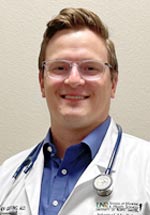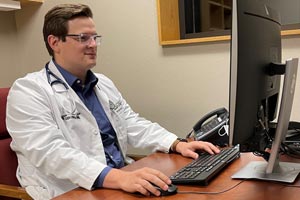From Dream to Doctor
By Stacy Kusler on

From a young age, Dr. Mat Gerving told people he was going to be a doctor someday. Early exposure to healthcare was thanks to his mom, who worked as a nurse while Gerving was growing up.
"I was a military kid until I was about 15 years old," Gerving said. "There would be days when my mom would take me to work with her so I wouldn't be home alone."
Gerving and his family moved around a lot during his elementary days, but settled in Beach, North Dakota when Gerving was a sophomore in high school. As he watched upperclassmen graduate, he noticed none of them had plans to pursue a medical degree. "We didn't have the school visits from health professionals or anything. It just wasn't a thing," Gerving said.
While not having footsteps to follow was intimidating, that didn't stop him from dreaming big.
Looking at UND
When graduation approached, the University of North Dakota (UND) was calling his name. Gerving had researched and found that UND had a reputable pre-medicine program; the first step in his path to becoming a physician. He made the 400-mile journey from the westernmost county in North Dakota, to the easternmost county, to begin his undergraduate studies in 2012.
Evelyn Boss is a health sciences advisor for the Student Academic Success & Career Engagement Office at UND. She serves as an advisor for students entering into any of the nine pre-health programs at UND. According to Boss, the pre-med program, specifically, sees enrollment of roughly 200 students per year. While pre-medicine is not a major itself, the curriculum can be applied to any other major at UND.
"Many pre-med students do go on to medical school, while others pursue different health careers," she said.
Boss notes that it takes more than just good grades to earn the white coat.
"Medical schools are looking for well-rounded applicants who demonstrate not only academic excellence, but also a dedication to service, as well as experience in healthcare," she said.
Gerving credits the help of the advisement services through the pre-med program that helped him earn his place in medical school.
I worked as a CNA (certified nursing assistant) because I was encouraged by my advisor that it would help my medical school application.
"I worked as a CNA (certified nursing assistant) because I was encouraged by my advisor that it would help my medical school application," Gerving said.
It certainly helped. He was accepted into the UND School for Medicine & Health Sciences (SMHS) in 2016 and joined 77 other students in the Doctor of Medicine class of 2020.
Discovering Rural Practice
Once Gerving's goal of becoming a physician was under way, it was time to hone in on what type of doctor he wanted to be. During medical school, he had heard about the RuralMed Program, which is a state-funded program that forgives medical school tuition in return for working in a rural North Dakota community for five years following residency.
Gerving wasn't sure if rural family medicine was the path he wanted to take, but it wasn't out of the question. As a third year student, Gerving participated in Rural Opportunities in Medical Education (ROME), where he spent 28 weeks in Hettinger, North Dakota. It was during his ROME experience that he found his calling.
I absolutely fell in love with rural practice.
"I absolutely fell in love with rural practice," he said.
He noted that his time spent with internal medicine physician, Dr. Joshua Ranum ('08), was pivotal in helping him understand, and love, what rural medicine was all about.
"I had such a good time during ROME," Gerving said. "You get the cardiology questions, you get the GI (gastrointestinal) questions, you cover emergency room, and run traumas, you do it all."
After that, it just made sense to sign onto the RuralMed program to assist with reducing education debt as he continued to pursue his dream, which now included a rural focus. It also helped him and his wife, Stephanie, breathe a little easier knowing medical school tuition was no longer a burden.
The Gervings, who were high school sweethearts, have three children and another on the way. Both have family who still live in Beach, and moving to a rural community after residency, especially close to family, was an easy choice to make.
Residency Training

Gerving is now in the middle of his second year of an internal medicine residency at UND SMHS in Fargo. While kids, family, and residency keep him busy every waking hour, Gerving continues to keep his sights set on a rural future.
Although his residency training is in the largest city in the state, he takes a special interest in patients who are transferred from rural areas. Gerving said he is always wondering how he can help patients get care closer to home.
"I am always asking the attending physician's opinion on ways to keep rural patients from having to be flown to larger cities. Things like increasing access to telemedicine, training for rural physicians, and other technology are very interesting to me," he said.
He wants other future physicians to think that way, too, noting that he encourages medical students who train with him to consider rural medicine.
I let them know that some of the smartest doctors I have worked with are rural medicine docs.
"I let them know that some of the smartest doctors I have worked with are rural medicine docs," Gerving said.
While he is eager to finish residency in 2023, he is taking advantage of his training and soaking up everything that will help him become a great doctor, and a rural physician leader.
After residency, Gerving plans to begin his internal medicine practice at Sanford Health in Dickinson, North Dakota, located just 60 miles away from grandparents and family in his hometown of Beach.


 is the connection between rural healthcare facilities in North Dakota and qualified health professional job seekers. As the workforce specialist, she assists rural facilities to attract medical providers and other health professionals to their communities by sharing job opportunities. Through her position, Stacy is working to reduce the healthcare workforce shortages throughout the state.
is the connection between rural healthcare facilities in North Dakota and qualified health professional job seekers. As the workforce specialist, she assists rural facilities to attract medical providers and other health professionals to their communities by sharing job opportunities. Through her position, Stacy is working to reduce the healthcare workforce shortages throughout the state.



